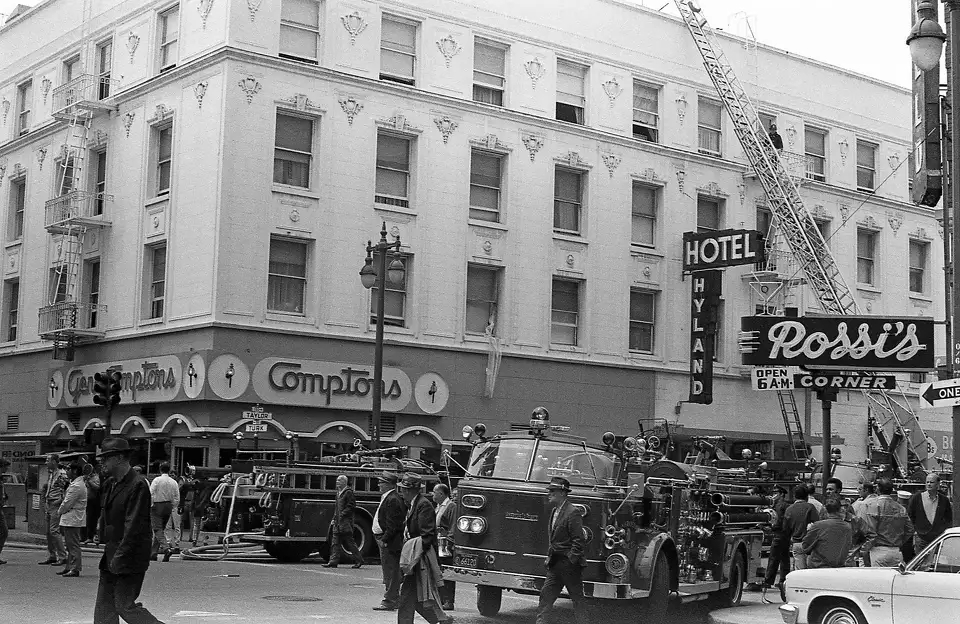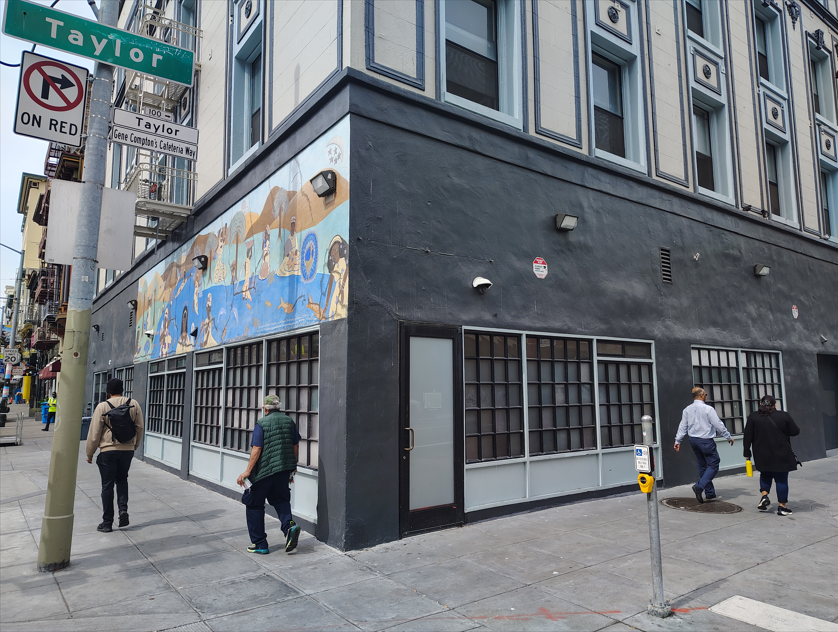Why You Should Know About the Compton’s Cafeteria Riot

By James Conrad
In the early 1960s, residents of San Francisco were not tolerant of homosexual and transgender people like most are today. The LGBTQ+ community tried settling in North Beach and South of Market. Targeted redevelopment and police harassment subsequently pushed them from these neighborhoods and into the adjacent Tenderloin. This is how the seedy neighborhood bordered by Van Ness Avenue, Market, Geary and Mason Streets became a queer stronghold.
This story is about Compton’s Cafeteria.
Before Stonewall, There Was Compton’s Cafeteria
Let’s start with an irrefutable truth. Like any good historian will tell you, transgender people have existed since the dawn of humanity. Teen Roman Emperor Elagabalus (c. 204–218 AD) lived as a woman despite being born male, even seeking out gender reassignment surgery. Indigenous tribes of North America recognized gender-nonconforming people within their communities long before colonization, revering them as visionaries for their ability to take on both a masculine and feminine perspective. The general public began to become more aware of gender dysphoria in the 1950s. WWII veteran Christine Jorgensen became the first person to successfully complete a gender transition.
Transgender folks that passed for cisgender could usually find traditional jobs. Those who could not faced severe systemic discrimination and were often left with no alternative but prostitution. Trans sex workers in San Francisco had zero societal protections and were frequently victims of police brutality. Not only was escorting illegal, it was also against the law for anyone born male to even present as a woman.
Mr. Gene Compton owned a chain of restaurants in San Francisco from the 1940s until the early 1970s. But one location at Turk & Taylor, 101 Turk Street, would see the beginning of a societal movement that continues today. Before Pride, before Stonewall, there was Compton’s Cafeteria. With the Summer of Love still years away, the city could be quite hostile to its queer population. Compton’s Cafeteria was gaining popularity among the Tenderloin’s transgender residents as a community refuge. To a community stalked, beaten, jailed and constantly rejected, even by San Francisco’s gay bars, no treasure could be greater. But that’s not to say the Cafeteria welcomed the community with open arms.
Fighting for the Right to Exist in Peace
In an interview with NPR from May 2015, local transgender activist Tamara Ching recalled, “It was good to go [to Compton’s] and be seen and talk to people about what happened during the night. To make sure everybody’s OK, everyone made their coins, everybody’s coming down off drugs and didn’t overdose, and that you didn’t go to jail that night. Compton’s nourished people. People would sit there for days drinking a cup of coffee. I would buy a full meal. I don’t cook and I loved eating at Compton’s—it was like downtown.”
Unfortunately, not everybody saw it that way. Staff at Compton’s would call police on the “female impersonators” they didn’t like. It didn’t take long for raids to become more frequent, as the cops could count on booking at least somebody.
RELATED: Old Man Keeps Complaining To Me about Trans Rights
By 1965, a group of gay and trans youth had formed an organization called Vanguard. Vanguard received sponsorship from the Glide Memorial Church the following year in June. Members held a protest outside Compton’s Cafeteria on July 19, 1966. The demonstration was initially deemed unsuccessful until Vanguard’s actions drew media attention, setting the stage for a momentous, violent revolution.
The exact date of the Compton Cafeteria Riot was lost to history over the years, but its message remains timeless. This particular fight for trans rights reportedly happened on a hot August night in 1966. The story goes that Compton’s Cafeteria staff called the cops, claiming a transgender customer was causing a disturbance. Long-existing tensions over loitering, open drug use and more meant conditions were ripe for an uproar. The cops arrived immediately. One officer was said to have used excessive force on a trans woman he was trying to arrest. In turn, she threw scalding-hot coffee in his face. The first Pride was a riot.
A Riot Ignites at Compton’s Cafeteria
A melee broke out. Patrons pelted police with coffee cups, silverware, sugar shakers, furniture, and anything else they could throw. Cops were clobbered with purses and pumps. Spiking the din, the chime of shattering glass made a theatrical appearance as the windows up front came down. The clash spilled outside onto the street. Rioters damaged a police car and set a nearby newsstand on fire. Members of the LGBTQ+ community staged a picket the following day after being refused service. The Cafeteria’s windows were shattered once more. The Stonewall Riots occurred three years later in similar fashion.
RELATED: There’s a rad new Compton’s Cafeteria Riot immersive show in the Tenderloin!
Transgender activists struggled to maintain numerous advocacy and support groups amid fierce police brutality and opposition from San Francisco residents. But the hatred toward transgender people was not unique to SF. Indeed, gay and gender-nonconforming people all over the United States risked it all by coming out. Compton’s Cafeteria meanwhile never recuperated, closing up shop for good in August of 1972. The relationship between the SFPD and local LGBTQ+ people remained uneasy throughout the next few decades. On Labor Day 1974, cops beat and arrested 14 gay men on Castro Street. A bunch of drunk and disorderly off-duty cops raided Peg’s Place, a lesbian bar on Geary Boulevard in March 1979. Two months later, ex-cop and city supervisor Dan White assassinated openly-gay fellow supervisor Harvey Milk.
A riot erupted at City Hall after White’s lenient sentencing. Sixty officers and 140 protesters were injured, and about two dozen arrests were made. Immediately afterward, cops exacted revenge via an unauthorized raid on a Castro Street gay bar, the Elephant Walk. In 1989, SFPD violently cracked down on a protest mounted by AIDS Coalition To Unleash Power (ACT UP), a response to the AIDS epidemic. Not until 2019 did the SFPD issue a formal apology for the department’s maltreatment of San Francisco’s LGBTQ+ community. Finally, in January 2025, the site of Gene Compton’s Cafeteria joined the National Register of Historic Places.


Howdy! My name is Katy Atchison and I'm an Associate Editor for Broke-Ass Stuart.
I want to take the time to say thank you for supporting independent news media by reading BrokeAssstuart.com. Supporting independent news sources like Broke-Ass Stuart is vital to supporting our community because it amplifies the voices of a wide variety of diverse opinions. You also help support small businesses and local artists by sharing stories from Broke-Ass Stuart.
Because you're one of our supporters, I wanted to send over a pro-tip.
Our bi-weekly newsletter is a great way to get round ups of Broke-Ass Stuart stories, learn about new businesses in The Bay Area, find out about fun local events and be first in line for giveaways.
If you’d like to get our newsletter, signup right here, it takes 5 seconds.


